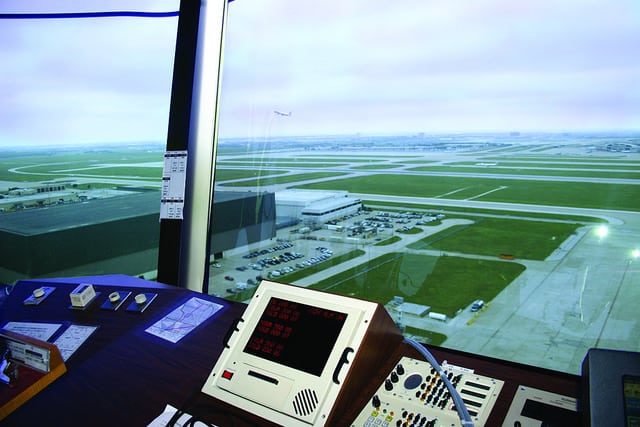
Dallas/Fort Worth air traffic control tower. (National Air Traffic Controllers Association)
The FAA is slow — Those are the words of Joshua Gustin, the Administration’s manager of communication, information and network programs. It is intentional, though.
“Be the safest, most reliable, biggest airspace in the world, with the most airplanes flying. That’s the job,” he said at the Air Traffic Control Association’s (ATCA) annual conference Wednesday during a panel on airspace infrastructure. “Not to get Wi-Fi, LTE put in. … We’re slow.”
That isn’t to say that the FAA isn’t interested in modernizing the U.S. national airspace system (NAS) — it is just that the ever-present caveat exists that innovation takes a backseat to safety and reliability. Gustin and colleague Chris Malitsky, a program manager from the FAA’s R&D branch, pointed out that the agency can move quickly with technological advancement in certain situations. For example, approving a first-of-its-kind drone operation to act as a flying cell tower in Puerto Rico in the wake of Hurricane Maria (which also required special exemption granted to telecommunications company AT&T to let the 55-pound drone fly under the small UAS rule). The FAA has also experimented with “putting LTE on top of a mountain,” Gustin said.
But, “the NAS is really big, and big typically translates to expensive,” he said. “To do things across the whole NAS is hard. By the time we implement, the next thing is right there.”
The speed of innovation in industry contrasted with the time it takes a big organization like the FAA to test, budget for and implement new technologies creates problems. What upgrades are going to be worth it in the long run? The FAA has to project which new technologies will be leverages and built on most in the future, the panel said, in order to avoid wasting time and money investing in something that will be obsolete by the time it has finished being implemented.
“Putting wireless into the NAS is not a success unto itself,” Gustin said. “If it doesn’t do anything, it’s just a data delivery system.”
Beyond that, the FAA has to contend with legacy technologies that bog down the process, particularly in the form of time-division multiplexing (TDM) signal processing systems.
“The problem is industry doesn’t slow down,” Malitsky said. “One of our challenges, really, on the procurement side is how do we specify a sliding network technology paradigm that’s really moving forward right now at a rapid pace. … The reality right now is we still have that anchor — that TDM anchor.”
One way the FAA can work to modernize while also future-proofing itself is to follow the industry’s lead in adopting a more agile, software-based, connected infrastructure. That way, even if some of the technology is abandoned in future instances, the agency won’t be hamstrung by outdated underlying hardware and can more easily and cheaply update to newer standards. Getting to that point, however, is an undertaking.
“All of our automation, all of those things are not IP (internet protocol)-capable because they were built in a different world,” Gustin said. “It works great today because there’s nothing wrong with it. But when we want it to be able to talk anywhere, it won’t be able to do about that.”
Gustin said the FAA is working to update to all-connected systems, but it will be a long process as it requires the agency to re-deploy “virtually everything we have deployed to get there.” He provided 10 years as a timeline, but admitted that it’s optimistic. “If it’s done then,” he said, “I will be very happy.
“But let’s say it is 10 years — are we still talking about 5g/LTE in 10 years? Hopefully, whatever we put underneath makes it easy to upgrade to whatever is new,” he added.
There is an issue that is somewhat exacerbated by the widening gulf created by the speed of industry’s innovation as the FAA works on the NAS: What is the FAA’s role in managing airspace infrastructure? How hands-on should it be? “As soon as you jump in, there’s an accountability that comes with it,” Malinsky said.
According to Gustin, the answer comes back to the first and second tiers of fulfilling the FAA’s basic responsibilities.
“We know our requirements. We want this reliability, this assurance that the system will be there tomorrow, be recoverable in a certain amount of time,” he said. “We want to be assured that when the system is degrading and leading to not meeting requirements, we can mitigate that ahead of time. How much do we need to be involved to provide assurance? That’s the challenge.”